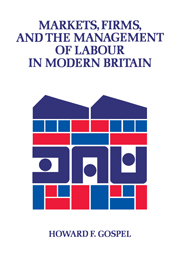Book contents
9 - Markets, firms, and the management of labour
Published online by Cambridge University Press: 23 November 2009
Summary
The purpose of this book has been to examine the development of labour management in Britain from the late nineteenth century more or less up to the present. It has argued that historically most British employers externalised many aspects of labour management and only slowly and hesitantly built strong internal structures. The fact that there were always exceptions to this general pattern and that a few large firms pursued strategies of internalisation is explained in terms of different market contexts, corporate structures and managerial hierarchies, and production technologies. In the following section the argument is summarised chronologically. The next section then reformulates the conclusions in more thematic terms. A final section reverts to the propositions outlined in Chapter 1 and draws some broader conclusions.
A chronological overview
The British economy in the late nineteenth and early twentieth centuries was characterised by a large number of small, family-owned and-managed enterprises catering for highly differentiated markets at home and abroad. Internally within most firms managerial hierarchies were weak, and owners often relied on various forms of sub-contracting and on largely independent foremen for workplace control. Some large enterprises existed, notably the railway companies, the gas companies, and a few manufacturing firms, and these had more extensive managerial hierarchies. From the 1870s onwards, British entrepreneurs witnessed an intensification in foreign competition, especially from Germany and the US, and there was a growing recognition of this competitive threat. One response was the merger wave at the turn of the century. However, this mainly resulted in loose defensive amalgamations held together as holding companies and there was a failure to develop more sophisticated managerial hierarchies.
- Type
- Chapter
- Information
- Markets, Firms and the Management of Labour in Modern Britain , pp. 171 - 189Publisher: Cambridge University PressPrint publication year: 1992
- 4
- Cited by



